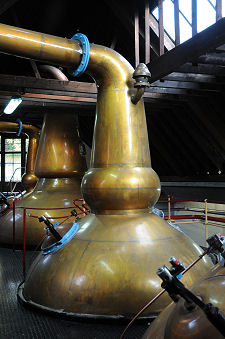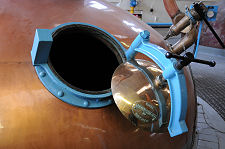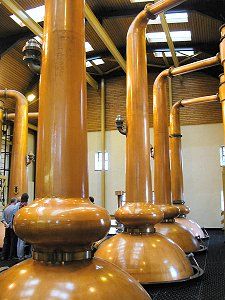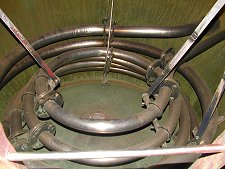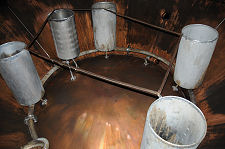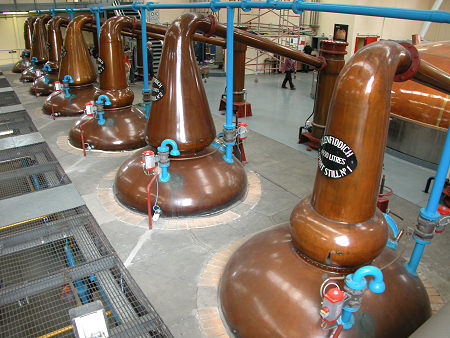 Glenfiddich's Unusual Paired Spirit Stills |
The spirit still, sometimes called the low wines still, is the second and usually final stage in the distilling process. Some distilleries distill more than twice, but double-distillation is the norm and is the process described here.
The spirit still takes as its starting point the contents of the low wines and feints receiver. This is a tank containing the low wines that have emerged from the wash still, together with the unwanted products from the last run of the spirit still itself. The result is a mixture of around 25% alcohol by volume.
Fundamentally, the job of a still has changed little since the days when every farmhouse in the Highlands could boast its own. Different constituent parts of the mixture have different boiling points, and the spirit that will later become malt whisky starts to boil only after a number of undesirable parts of the mixture have boiled off and before other, equally undesirable, parts of the mixture begin to boil.
Having boiled in the still, the vapour makes its way out of the top of the still (often after condensing and falling back many times within the neck of the still itself) and along a lyne arm leading into the still's condenser. This cools the vapour and converts it back into a liquid, before channelling it to the spirit safe. (Continues below image...)
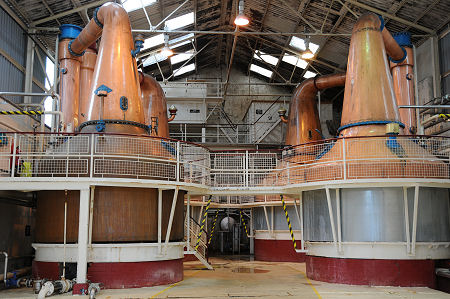 Two Spirit Stills (Nearest the Front) at Ben Nevis Distillery |
The role of the distiller is twofold. First to allow the undesirable initial products of the still, the "head" or the foreshots, to drain off, before capturing the spirit that is wanted, the "heart". And second, to ensure that the collection of the spirit ceases before the undesirable higher boiling point materials in the "tail", or the feints, begin to emerge from the still. This process is managed by the distiller using the spirit safe.
The spirit, the "heart" that emerges from the spirit still via the condenser and spirit safe goes into the spirit receiver to be put in casks. At this stage it is about 70% alcohol by volume. The foreshots and the feints, the unwanted "head" and "tail" go back to the low wines and feints receiver to mix with the next batch of low wines from the wash still before being returned for another trip through the spirit still.
The physical and chemical processes taking place within the still are very complex and not all are totally understood. What is clear, however, is that a number of different factors have an effect on the quality and taste of the malt whisky that the spirit eventually becomes. One important factor is the material from which stills are made, copper. This acts as a catalyst and promotes a number of chemical reactions within the still: indeed, the copper of the stills is slowly consumed by the process, and stills will regularly have thin sections replaced.
The shape of the still is also critical to the quality of what emerges. A wide variety of different shapes and sizes are in use across distilleries. Some like Glenmorangie's are tall, at 17ft the tallest in Scotland. The originals back in 1843 were second-hand gin stills. Other stills are dumpy. The bases of some stills are almost spherical in shape, while others have a broader or flatter profile. Some have secondary chambers just above the main vessels, while others settle for a variety of neck shapes. And the simple size of a still makes a difference, changing the surface area of the copper in contact with the spirit.
But while there is no agreement about the best shape for a spirit still, there is unanimous agreement that a distillery's stills are critical to the character of its whisky. When a still needs to be replaced it is usually replaced with one as nearly identical to the original as the distiller can manage. And when the capacity of a distillery is increased it is usual to invest in more stills identical to the ones already in use rather than to increase the size of the stills. At Glenfiddich the spirit stills operate in differently shaped pairs, with the output from each pair being combined as it emerges.
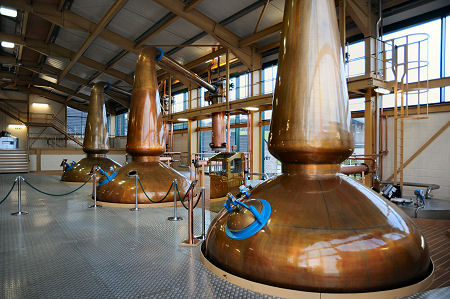 Spirit Stills at Glenlivet Distillery |
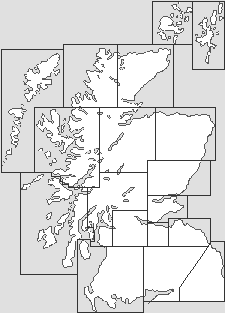
|
|
|
Making Malt Whisky: |
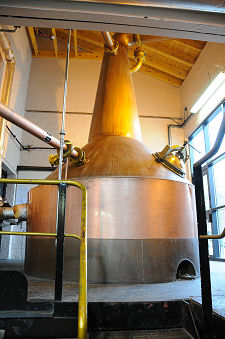 Spirit Still, Glenturret |
 Spirit Still, Ardbeg |
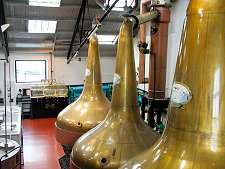 Bowmore's Spirit Stills |
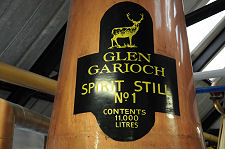 Spirit Still at Glen Garioch |
